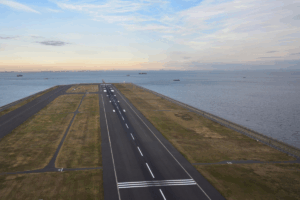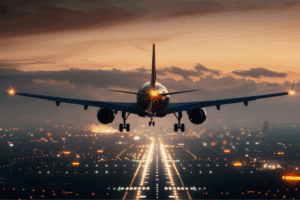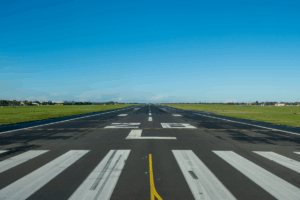Extreme weather conditions can strike at any time, in any place, and with varying degrees of severity. The effects of harsh weather on airport lighting fixtures, wiring, control equipment, and other components can be devastating to normal operations, significantly impacting the system’s ability to support runway and taxiway safety.
Although there’s no way to stop extreme weather from occurring, airport operators can take steps to help mitigate the effects on their runway lighting systems. However, it’s first essential to understand how snow, sand, temperature fluctuations, and other weather-related conditions and events can impact their runway lighting infrastructure.
How Can Extreme Weather Affect The Performance Of Airport Runway Lighting Systems?
One might not expect that an airport in a northern location faces the same weather threat as one operating in a desert, but they, in fact, have a common enemy: high-velocity winds.
Wind can blow snow or sand into every exposed crevice in your airport lighting system, clogging mechanical parts or shorting electrical components. Additionally, windblown snow and sand can pile up in front of your runway beacons, compromising their ability to emit visible light.
Ice can also cause concern, as it can accumulate on lenses and wiring, potentially affecting performance. During the spring thaw, water from melting ice can trickle into the tiniest fissures in your equipment and damage internal components. Water can also pose a threat in areas with high humidity or located in coastal regions, as moist and salty air can corrode metal and expose sensitive components to the elements.
Airports located where the temperature fluctuates drastically are also at risk. For example, areas that experience scorching summer temperatures during the day and sub-freezing conditions at night can see expansion and contraction in the metals, plastic parts, and wiring insulation of their runway lighting equipment. If left unchecked, these repeated cycles can lead to cracks in the system’s components, making electrical connections vulnerable to damage.
Plan For Extreme Weather Conditions When Designing Your System
There can be no compromises when it comes to airport safety, which demands nothing short of consistent reliability from your runway lighting system. You can take steps to protect your equipment from damage at the system design stage or during a retrofit by understanding your local environment and taking appropriate measures that will keep your runway lighting operating reliably under any extreme weather conditions.
Strategies you can take to safeguard your equipment include:
- Adopting LED technology for your runway lights, as they have been proven to operate reliably and consistently in climates that experience severe temperature fluctuations
- Use hardware and fitters made from corrosion-resistant materials such as stainless steel, titanium and titanium alloys, aluminum and aluminum alloys, and nickel-based alloys that withstand degradation in salty or humid environments
- Protect your external equipment surfaces from rust with protective coatings, such as powder coats or specialized paints
- Use sealed enclosures designed with features such as gaskets, seals, and drainage channels to prevent water penetration and condensation buildup, helping you avoid short circuits and equipment failure
Read More: 5 Considerations When Upgrading Your Airport Runway Lighting System
Maintaining Your Airport Runway Equipment In Harsh Climates
Once you have your weather-resistant equipment in place, it’s crucial to perform regular maintenance to ensure it delivers reliable performance on a consistent basis. Periodically check mounting bolts and couplings for proper torque, and inspect your equipment for signs of fixture movement, tilting, or shifting after storms.
Regular visual inspection of your bulbs, lenses, power cables, and other components must be carried out to ensure everything is working as required. Areas that experience heavy snowfall or sand drifts will need more frequent maintenance to clean your fixtures of any ice, dirt, sand, or other debris buildup that can interfere with light output. Airports with solar-powered systems will also need to ensure that solar panels are clear of obstructions.
Here are some additional technical tips for protecting your airport runway equipment:
- Use FAA-Compliant, Wind-Resistant Fixtures
- Certified Fixtures: Ensure all lighting fixtures are FAA-approved (per AC 150/5345 series) and rated for wind loads consistent with FAA Engineering Brief No. 67
- Wind Load Ratings: Fixtures should meet minimum structural integrity standards (often 300+ mph for certain applications)
- Low-Profile Fixtures: Use in-pavement or low-profile elevated fixtures where possible to reduce wind exposure
- Reinforce Mounting Systems
- Base Cans & Couplings: Use deeper and/or reinforced base cans and frangible couplings properly torqued and sealed
- Anchor Bolts: Securely anchor fixtures into concrete pads or base cans with corrosion-resistant hardware
- Thread Lockers: Use thread-locking compounds on bolts to resist vibration loosening
- Use Frangible (Breakaway) Mounts Correctly
- Designed to break cleanly if struck or stressed, frangible couplings reduce stress transfer to the mounting system while minimizing debris in high-wind events
- Install at the correct torque and height per FAA guidance (AC 150/5340-30 series)
- Protect Cabling and Conduits
- Direct-Burial or Encased: Use direct-burial rated cable or bury conduits in concrete/asphalt to prevent exposure
- Strain Reliefs: Add slack loops or strain reliefs to avoid pull damage when fixtures move or shift under stress
- Sealed Connections: Ensure watertight connections to prevent moisture ingress after strong wind-driven rain
- Harden Critical Infrastructure
For key systems like REILs, PAPIs, ODALs, and wind cones, consider:
- Wind-rated enclosures and support poles
- Guy-wires or internal reinforcement in hurricane-prone areas
- Elevated equipment shelters for electronics
- Design for Jet Blast and Taxiway Wind Shear
- Strategic Placement: Position lights outside known jet blast zones where possible.
- Blast Shields or Berms: Install barriers to redirect airflow if exposure is unavoidable.
- Use Tethering for Temporary Fixtures: For portable lights, use proper guying and anchoring systems
- Regional Considerations
- In hurricane zones, follow ICAO and FAA guidelines for Category 4 or 5 wind loading
- Use local wind load codes (e.g., ASCE 7 or IBC standards) to determine installation specs
Read More: Maintenance Routines For Inset Runway And Taxiway Lighting Systems
Advanced Technology That Will Help You Maintain Efficient Operations
You can also keep your airport operational by installing advanced technology such as the L-890 Airport Lighting Control and Monitoring System. Not only does this tool provide remote control of your runway lighting systems, but it also offers real-time monitoring of your components, providing extensive alarm and reporting capabilities in the event of a potential failure. This proactive approach to lighting maintenance helps you get ahead of system issues between scheduled maintenance checks, enhancing the safety of your operation.
Protect your airport from unexpected power failure due to extreme weather with a ferroresonant power supply. These stackable units are designed to provide power under extreme operating conditions without being affected by surrounding electrical systems. Its resonant circuit ensures constant and reliable output voltages even if the input voltage varies due to power instability or other energy disturbances.
For more effective strategies to protect your airport lighting equipment from damage caused by harsh weather conditions, contact the experts at Airport Lighting Company. We’re here to connect you with advanced technology solutions that ensure safe and reliable performance from your airport lighting system for decades to come.
Call Airport Lighting Company For The Latest In Airport Lighting Technology
The Airport Lighting Company team is standing by to answer your questions about how our tech-based products can help improve the safety, reliability, and efficiency of your runways. Call 315-682-6460 for fast, friendly service you can count on.


